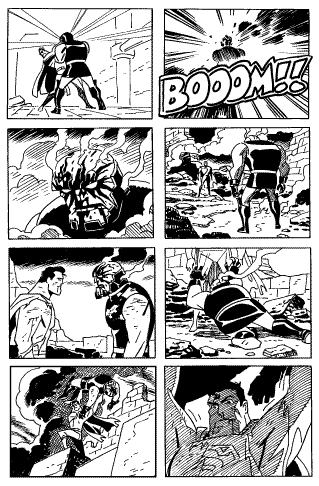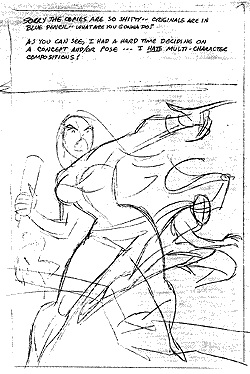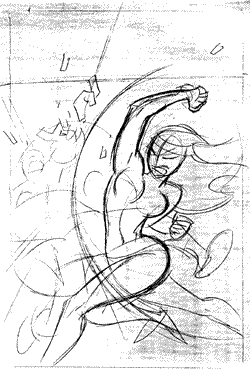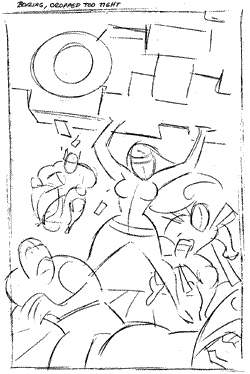 Selected panels from Bruce's storyboard for the Fourth World finale
episode of the Superman animated show. Bruce notes, "It's called 'Legacy,'
and is set to air in January. It turned out to be the Superman series
finale as well. Courtesy of the artist. ©1999 Warner Bros. and DC Comics,
Inc. Superman, Kalibak, and Darkseid ©1999 DC Comics, Inc.
Selected panels from Bruce's storyboard for the Fourth World finale
episode of the Superman animated show. Bruce notes, "It's called 'Legacy,'
and is set to air in January. It turned out to be the Superman series
finale as well. Courtesy of the artist. ©1999 Warner Bros. and DC Comics,
Inc. Superman, Kalibak, and Darkseid ©1999 DC Comics, Inc.
Timm of the New Gods
Chatting with Bruce Timm about Kirby's Fourth World
Conducted by Jon B. Cooke
Transcribed by Jon B. Knutson
From Comic
Book Artist Special Edition
I recall the moment I discovered Bruce Timm's work.
I sat in my parked minivan, waiting for my wife to be done with
some appointment, and I started to glance through Batman Adventures
Annual #2 I had picked up because I was attracted to the Kirby
riffs inside. Well, from that moment on, I have been thunderstruck
by Bruce's astonishing ability as a premier cartoonist. He is
mostly known as art director and producer of the lauded Batman
animated show, but one look at his graphic novel (scripted by
Paul Dini), Mad Love, proves he is a comic book artist to be reckoned
with. Seek him out in the (unfortunately) too few places his artwork
has appeared and you will assuredly become one of the converted.
And though he was knee-high to a grasshopper when the other creators
in this Special Edition were producing some mean work, Bruce drew
and colored the perfect Big Barda cover for us (thanks, Timm!),
and I'll feature Bruce coz' he damn well deserves it! The artist
was interviewed via phone on November 5, 1999, and he copyedited
the transcript.
COMIC BOOK ARTIST: When did you first discover Jack Kirby's
Fourth World?
BRUCE TIMM: In 1972 or '73. I was always interested in comics,
but I never really bought a whole bunch of them. I watched super-hero
shows on TV, but I'd always spent my allowance on Hot Wheels, things
like that, instead of actually buying comics. But in '73, I really
started collecting them seriously. When I was going to junior high
school, I had lunch money, which I could spend on comics instead of
lunch. [laughter] The only Fourth World title still being published
at that time was Mister Miracle, and I got two issues of that, but
I didn't actually discover the rest of the Fourth World until later,
when I bought back issues. I was aware of Kirby from the Marvel cartoons,
but without actually being able to put his name on the style. So it
was right around '73 or '74 when I started really getting into comics
that I started putting it all together, and realized, "Oh, yeah, this
is that guy!" It's funny, because I had a love/hate thing with Kirby
for a while there; I wasn't sure that I really liked this stuff or
not. I'd go back and forth, and say, "Well, this is really kind of
sloppy, weird and strange-looking." But I'd keep going back and looking
at them.
CBA: The style was compelling?
BRUCE: Yeah, kind of. I was that way with a lot of people
when I was first getting into comics. My first heroes were John Buscema
and Neal Adams. I was much more into the "slick," realistic style,
and Gene Colan was one of my top favorites. So, a lot of the people
I love now, I wasn't really crazy about back then; I wasn't crazy
about Kirby, I wasn't really crazy about Alex Toth. I'd look at Toth
and think, "My god, this stuff is like kiddie drawings! It's like
coloring book drawings, they're so simple," but I'd keep going back,
looking at them, saying, "If I don't like this, why do I keep looking
at them?"
CBA: You obviously clued into a Kirby/Toth synthesis as a
style you were trying to achieve?
BRUCE: Well, you know, I don't even know if it was a conscious
effort. My "style," when people talk about it, they're actually probably
referring to the Batman animated style, for which I'm most known.
CBA: When you first bought the Fourth World material, did
Kirby become very important to you? I can't even think of any other
artists who have been able to clue in so successfully to what Kirby
was doing. Not only did you overtly use his material in the Superman
cartoon show, but it also showed up in your comic book work. I recall
picking up a Batman Adventures Annual which featured a dead-on version
of The Demon. My eyes popped because you "got it"; you understood
Kirby's approach.
BRUCE: Well, we were really consciously at that point trying
to do a lot of Kirby stuff in that Annual. That was overt; we wanted
to really put as much Kirby into it as possible without actually doing
a swipe. Anytime I do something that I think is specifically a Kirby
homage, I try not to do an actual swipe, and I'll have a lot of his
stuff in front of me, but I won't actually swipe a whole pose or a
face or anything. I just have his material there as an osmosis kind
of thing - trying to pull up the vibe from it. But yeah, that was
one that I and Glen Murakami, who worked on that annual with me, we
were really trying to achieve. Well, the thing with The Demon, especially,
is that the character had gone through so many permutations in the
DC universe since the Kirby days - they'd changed him so much - so
I thought, "Well, gosh, he's hardly even the Kirby Demon any more,
so if we're going to use him in the Annual, we should go back to the
source and try to make it as true to Kirby as possible."
CBA: Your comic book work is quite sparse. It's difficult
to even find it on a yearly basis nowadays. Do you plan in the future
to be doing... do you have any time?
BRUCE: Well you know, that's the problem: It's the time it
takes to do it. I recently did Avengers #11/2. That was something
that I fell into doing for Marvel. Again, it's a direct Kirby homage,
and all the way through I tried to make it look as much like Kirby
as possible, more than anything else, and I honestly think I failed.
I look at it and I think, "It doesn't really look like Kirby, and
it doesn't look like me, it's kind of neither fish nor fowl." People
really seemed to like it, but....
CBA: So you're not happy with it?
BRUCE: Like I said, it's neither 100% Kirby or 100% me, it's
somewhere in-between, and it's just... whatever. A lot of people
tell me, "It looks just like Kirby," and I'm just like, "Oh, well,
that's nice." It frustrates me on that level. Anyhow, getting back
to your original question, to actually take the time out to do a 25-page
comic, I actually had to take a week off of work just to pencil the
thing, because I have this really demanding day job, and I've got
a wife and daughter, and when I get home, I want to spend time with
them, so finding time to actually do a full comic is pretty back-breaking.
As much as I enjoy doing comics, I wish they paid as well as my animation
work. I'd probably do them full-time!
CBA: So your animation work is going full gangbusters right
now?
BRUCE: Oh yeah, big time. We're cranking away on Batman Beyond.
CBA: That's a daily show?
BRUCE: No, not yet. Warner Bros. wants to get it to the point
where they have enough episodes so they can actually strip it and
run it Monday through Friday, but they don't have enough yet. I think
it's on twice a week - one day during the week, and Saturdays as well.
We're doing 52 episodes total, and we're still working on them.


 Bruce's concept sketches for this issue's cover, all courtesy of
the artist. Bruce notes, "As you can see, I had a hard time deciding
on a concept and/or pose... I hate multi- character compositions!" Big
Barda and the Female Furies ©1999 DC Comics, Inc. Art ©1999 Bruce Timm.
Bruce's concept sketches for this issue's cover, all courtesy of
the artist. Bruce notes, "As you can see, I had a hard time deciding
on a concept and/or pose... I hate multi- character compositions!" Big
Barda and the Female Furies ©1999 DC Comics, Inc. Art ©1999 Bruce Timm.
CBA: Is anything up with Superman any more?
BRUCE: Superman is officially on hold for the time period.
I kind of doubt we're going to go back to doing any more. There doesn't
seem to be much interest from the network or from the lot to do more
Superman, but if they ever get the Superman live-action movie up and
running, then chances are, that might spark some interest in doing
more cartoons. But for the time being, it's pretty dead.
CBA: The Superman cartoon show was full of obvious homages
to Kirby - there was even a character, Terrible Turpin, who was, for
all practical purposes, Jack Kirby as a cartoon character. Do you
see the Fourth World creations as a perfect setting for Superman?
BRUCE: The Fourth World certainly blended in very well with
the character. Of course, Kirby started that himself, with Jimmy Olsen,
and even in recent years, Mike Carlin has re-introduced a lot of the
Kirby elements back into the Superman strip. It was certainly a good
blend. I think one of the problems we always have with Superman is
that the character's been around for so long, and he's kind of such
a... I don't want to say dated, but you know what I mean? There's
nothing terribly modern about Superman; he's been around for so long.
His costume is so primary, and he's such an icon that it's hard to
find anything fresh and original about him, so bringing the Kirby
mythos into the Superman universe seemed to be a way to introduce
a new element, to make people interested in the character. Even though
the Fourth World stuff has been around for a long time, it's not something
that's been seen on a mass media exposure.
CBA: If you could, do you have more Fourth World stories you'd
love to do?
BRUCE: You know, it's so hard to say. On one hand, I go back
to them a lot and re-read them (or try to re-read them - they're kind
of all over the place), it's a hard thing to really get a grasp on.
People keep saying, "Why don't you do a Fourth World series or a movie
or something," and I don't really know how to do it. In a way, it
was nice that we introduced it into Superman because we didn't have
to concentrate solely on the Fourth World, and try to figure out exactly
how to make it work. We were able to use elements that worked on a
more commercial aspect, reducing Darkseid's whole central being and
mythos into something that's kind of easily palatable to our key audience.
But the whole thing is such a big mind-expanding concept, it's so
huge! To this day, I think that it kind of got beyond Kirby; I mean,
Kirby couldn't even control it all, coming up with concepts so fast,
he'd lose sight of what the story was. If you go back and re-read
the entire run of The New Gods, the first three issues are, "Wow,
he's really onto something!" But by the fourth issue, he's introducing
new characters, and something is getting lost in the mix. All of his
comics are created that way: The first two or three issues of The
Eternals are like, "Wow, he's really on to something," and then, "My
God, now where are we going?" [laughter] So, a lot of people say,
"Well, it's not fair because Kirby never really got a chance to finish
the Fourth World," and I'm not sure he really had anything in mind
as a complete story, even though he said he did.
CBA: Do you feel George Lucas and his Star Wars movies were
influenced by Jack's Fourth World?
BRUCE: I don't see how he couldn't have been. It's entirely
possible that he came up with these similar concepts on his own (because
we've done that as well - we'll come up with a character for the Batman
or Superman show, and suddenly find out, "Oh, my God! There's another
character out there exactly like that, in the exact same type story!"),
but the similarities between Darkseid and Orion with Darth Vader and
Luke Skywalker, and the whole bit about the Source and the Force...
it's all so close, you have to think... I don't know. Lucas hasn't
really touched on that in interviews, and I'm not sure anybody has
ever directly confronted him with the similarities. But I definitely
think the New Gods had an impact on Star Wars, or at least was influenced
by it. Certainly, Jim Starlin has always said that his whole Captain
Marvel and Thanos thing was directly inspired by the Fourth World
stuff, and that had an impact on comics in general.
CBA: What were you trying to achieve with the cover you did
for CBA Special Edition #1?
BRUCE: John Morrow basically told me he wanted me to do something
Fourth Worldish. I was trying to create an image that was not something
that you've seen a million times - I didn't want to just do Orion
punching out Kalibak, something with Darkseid, or whatever. And because
I do like to draw sexy gals, I thought, "Well, I'll do something with
Barda," so it just kind of came from there. I did about 10 or 15 sketches
before I finally landed on the one that worked, composition-wise,
so... I went with that.
CBA: Is Kirby a part of you?
BRUCE: Definitely, absolutely. Though I'm closely associated
with Batman, I grew up as a Marvel kid, and Marvel Comics were always
my favorite. I wasn't into DC Comics very much at all (except for
Batman), and seeing as how Kirby is really synonymous with the whole
Marvel mystique, it's kind of a very deep part of my being. It's really
odd, I actually live within shouting distance of his burial site,
so I pass by it all the time, and I always end up saying, "Hey, Jack!"
when I pass by.
CBA: Did you ever meet him?
BRUCE: I only met him once or twice at conventions, and I
never really had a conversation with him or anything. I just said,
"Oh, Jack, I'm a big fan, blah-blah-blah." It's happened every time
I've met one of my idols; when I met Frazetta, it was the same thing,
and I didn't really know what to say to him.
CBA: What can you say, really? You've obviously been in animation
for some time. Would you, if you could live your dreams, love to get
your hands on Marvel characters to do an animated series?
BRUCE: [laughs] This is opening up a whole can of worms! With
the current management at Marvel Entertainment, I don't think they
would let me do what I want to do with the characters. I don't know
if you've actually seen any of their recent cartoons, Spider-Man Unlimited
and The Avengers, or whatever, but I think the direction they're going
in with the Marvel characters is the wrong direction. So, if I could,
sure; are you kidding? Yeah, at one point, it was probably about five
or six years ago, after we finished up the first season of Batman,
there was a period right after the Image guys left and Marvel was
really financially floundering, and they made some overtures to Warner,
to see if we were interested in buying any of their characters, and
I just jumped out of my skin! I said, "Oh, my God, yeah! Give me the
Fantastic Four! I'll do the Fantastic Four!" I guess they actually
looked into it, and there seemed some kind of anti-trust thing, so
it didn't go anywhere. Didn't happen; probably never will.
These are just excerpts from Bruce Timm's interview.
SOLD OUT!
This issue is currently unavailable from TwoMorrows.To make subscription and back issue orders easier for our readers (especially
those overseas), we now accept VISA and MASTERCARD on our secure
web store! ( Phone, fax,
mail and e-mail
accepted, too!)
 

Sign up here to receive periodic updates about what's going on in
the world of TwoMorrows Publishing.

Click here to download
our new Fall-Winter catalog (2mb PDF file)
|
